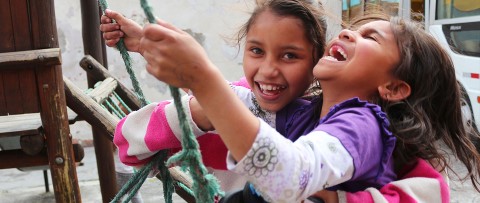- Thought Leadership

“It’s a child’s right to play.”
Kids are born explorers — naturally curious about their environments and eager to learn about them. They navigate their worlds through trial and error. And when they have a safe place for full expression and worry-free play? They flourish.
But kids in poverty don’t have easy access to such areas. See-saws and swings simply aren’t common in the poverty-stricken communities where CI works. Instead, kids create their own playgrounds — in crime-ridden neighborhoods, stagnant and polluted rivers, busy roads, rocky construction zones and landfills.
![]()
The community of Chibolya in Zambia, Africa, is one of the most dangerous areas in Lusaka thanks to its high crime rate and drug-related violence. The city hasn’t built parks here in fear of vandalism and theft. Instead, kids find dusty roads and their rocky front and backyards to be the only play areas. But they’re also hazardous — a lack of drainage system or designated dumps mean garbage is everywhere. Injuries due to glass, rusty nails and stagnant water are common.
Just on the other side of the CI community center wall, kids don’t have to worry about such risky elements. The community center is a safe haven where kids can be kids without the worry of injury or sickness. On the outdoor playset, they can spend hours chasing each other or inventing fantastic worlds and magical places: Sailing the ocean on a ship, traveling the cosmos on a spacecraft or riding through forests in a carriage to a luxurious castle. They become adventurers, heroes and royalty capable of accomplishing anything.
![]()
In the Bicol region of the Philippines, kids who aren’t sponsored hang out and play on the dike that separates the slums where they live from the sea. Below the dike are tunnels that dump processed city sewage into the water.
But at the local community center, CI kids can craft Lego masterpieces, be transported to another world through books, engage in a little friendly competition through board games, and so much more. These spaces are an important part of a child’s development. And CI lets kids discover there’s no limit to their imaginations.
“I found a lot of unsafe places for children.”
Functional playgrounds are difficult to find in a northern Quito, Ecuador, community, says our field reporter Andrés Rosero: “I found a lot of unsafe places for children, but I don’t think they can have fun because all the toys are destroyed, and you can see a lot of garbage around the parks.” Crime in the community also prevents kids from enjoying the parks.
Fortunately, sponsored kids can head to the local CI community center. Although space constraints don’t allow room for a playground, children and teens have access to a computer center, a library filled with games, toys and books and a multipurpose room that serves as a hub for fun programs that teach skills crucial to their emotional, physical, social and creative growth.
![]()
It’s common to see nonsponsored kids playing soccer in garbage-strewn fields in this community in Barranquilla, Colombia. These areas are especially dangerous for kids who are barefoot; broken glass, rotting food, excrement and rodents can cause infections.
CI kids, on the other hand, can safely kick the ball around at the Nicole Lyn Anderson Community Center, which features a spacious sports court and plenty of playground equipment — not to mention all the awesome games and books in the library!
CI kid Jordi T. in Santo Domingo, Dominican Republic, prefers playing basketball at the CI community center to swimming in this well.

Some kids sneak off to swim in this trash-filled water well in Santo Domingo, Dominican Republic. But CI kid Jordi T. (12) recognizes the risks. “I don’t like to swim here because it is dangerous,” he says. “I prefer to visit the [CI community] center and play on the basketball court.”
![]()
At the Phelan Center at Los Tres Brazos, the basketball court doubles as a multisport court, where CI kids can participate in Sports for Development programs. Right next to the court is a playground and more meeting space for youth programs that teach life skills like decision-making, effective communication, self-awareness and more.
![]()
North of Quezon City in the Philippines is this bridge, which separates two neighborhoods that house many sponsored families. Kids must cross this bridge on the way to school every morning. But while CI kids can head to the community center after classes, says our field reporter, Pauline Paguia, the bridge turns into a play area for nonsponsored kids. Not the safest place for fun, thanks to the polluted river.
Though small, the local CI community center features an activity center where kids can hang out with their friends and participate in fun, educational activities. “Play areas are very important, because not all communities have play-friendly areas due to limited space,” says Israel Bombarda, a CI field officer in Manila, Philippines. “It’s a child’s right to play,” Israel adds. “Children International lets them play on safer ground.”
It’s your turn to channel your inner kid! Download and print the CI playgrounds coloring page. Share your creations on Instagram and Facebook and tag them with #CIcoloring and #coloring.
Comments
Cherela
Jan 24, 2017
I love seeing the happy kids at the CI centers. Thanks for all you are doing! ❤
kteed
Mar 25, 2018
I find it sad that there’s so many millionaires and billionaires in this world yet still with all that money which they couldn’t spend in ten lifetimes we still have so many that have such great need. A real shame. I wish I could do more but I’m happy that I touch at least one life who maybe touches another with love and compassion and one day will pay it forward.
You must be logged in to comment. If you have an account, click here to log in.